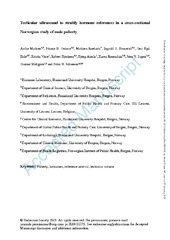| dc.contributor.author | Madsen, Andre | en_US |
| dc.contributor.author | Oehme, Ninnie | en_US |
| dc.contributor.author | Roelants, Mathieu | en_US |
| dc.contributor.author | Bruserud, Ingvild Særvold | en_US |
| dc.contributor.author | Eide, Geir Egil | en_US |
| dc.contributor.author | Viste, Kristin | en_US |
| dc.contributor.author | Bjerknes, Robert | en_US |
| dc.contributor.author | Almås, Bjørg | en_US |
| dc.contributor.author | Rosendahl, Karen | en_US |
| dc.contributor.author | Sagen, Jørn V. | en_US |
| dc.contributor.author | Mellgren, Gunnar | en_US |
| dc.contributor.author | Juliusson, Petur Benedikt | en_US |
| dc.date.accessioned | 2020-08-03T07:25:42Z | |
| dc.date.available | 2020-08-03T07:25:42Z | |
| dc.date.issued | 2020 | |
| dc.Published | Madsen AG, Oehme NHB, Roelants M, Bruserud IS, Eide GE, Viste K, Bjerknes R, Almås B, Rosendahl K, Sagen JV, Mellgren G, Juliusson P. Testicular ultrasound to stratify hormone references in a cross-sectional Norwegian study of male puberty. Journal of Clinical Endocrinology and Metabolism 2020;105(6):1888–1898 | eng |
| dc.identifier.issn | 0021-972X | |
| dc.identifier.issn | 1945-7197 | |
| dc.identifier.uri | https://hdl.handle.net/1956/23357 | |
| dc.description.abstract | Context: Testicular growth represents the best clinical variable to evaluate male puberty, but current pediatric hormone references are based on chronological age and subjective assessments of discrete puberty development stages. Determination of testicular volume (TV) by ultrasound provides a novel approach to assess puberty progression and stratify hormone reference intervals. Objective: The objective of this article is to establish references for serum testosterone and key hormones of the male pituitary-gonadal signaling pathway in relation to TV determined by ultrasound. Design, Setting, and Participants: Blood samples from 414 healthy Norwegian boys between ages 6 and 16 years were included from the cross-sectional “Bergen Growth Study 2.” Participants underwent testicular ultrasound and clinical assessments, and serum samples were analyzed by liquid chromatography tandem–mass spectrometry and immunoassays. Main Outcome Measures: We present references for circulating levels of total testosterone, luteinizing hormone, follicle-stimulating hormone, and sex hormone–binding globulin in relation to TV, chronological age, and Tanner pubic hair stages. Results: In pubertal boys, TV accounted for more variance in serum testosterone levels than chronological age (Spearman r = 0.753, P < .001 vs r = 0.692, P < .001, respectively). Continuous centile references demonstrate the association between TV and hormone levels during puberty. Hormone reference intervals were stratified by TV during the pubertal transition. Conclusions: Objective ultrasound assessments of TV and stratification of hormone references increase the diagnostic value of traditional references based on chronological age or subjective staging of male puberty. | en_US |
| dc.language.iso | eng | eng |
| dc.publisher | Oxford University Press | eng |
| dc.subject | puberty | eng |
| dc.subject | hormones | eng |
| dc.subject | reference interval | eng |
| dc.subject | testicular volume | eng |
| dc.title | Testicular ultrasound to stratify hormone references in a cross-sectional Norwegian study of male puberty | en_US |
| dc.type | Peer reviewed | |
| dc.type | Journal article | |
| dc.date.updated | 2020-01-20T13:43:07Z | |
| dc.description.version | acceptedVersion | en_US |
| dc.rights.holder | Copyright 2019 Endocrine Society | |
| dc.identifier.doi | https://doi.org/10.1210/clinem/dgz094 | |
| dc.identifier.cristin | 1764411 | |
| dc.source.journal | Journal of Clinical Endocrinology and Metabolism | |
| dc.identifier.citation | Journal of Clinical Endocrinology and Metabolism. 2020, 105 (6), 1888–1898. | |
